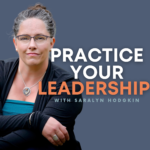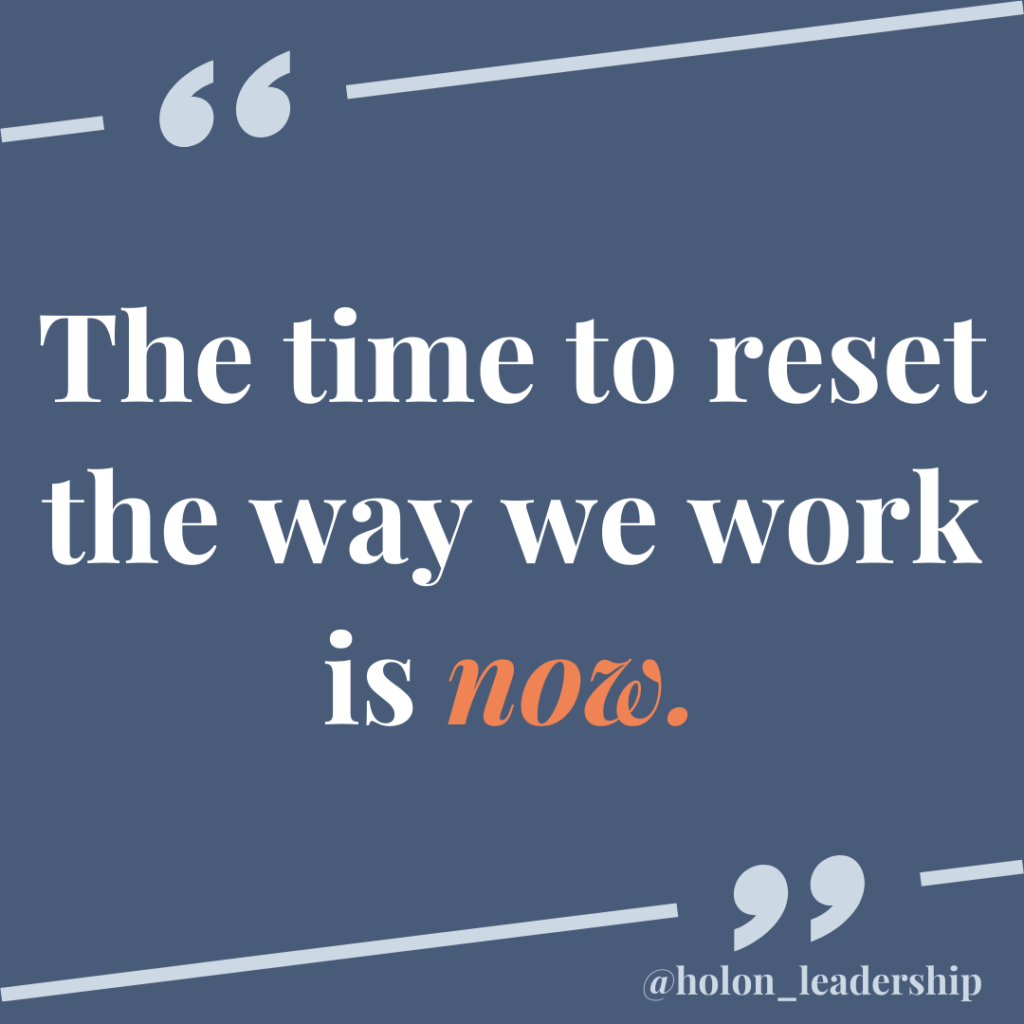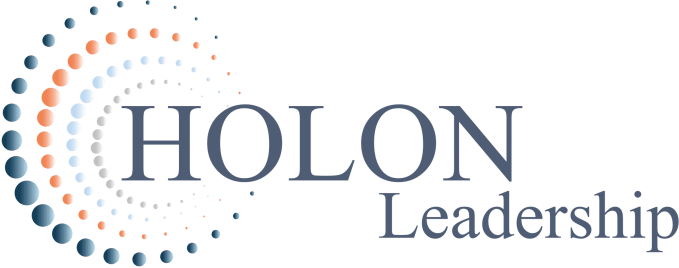You’re coming into work. Possibly working as a team, maybe your organization, your team is hybrid. Maybe they’ve demanded everybody has to be in person. Maybe everybody’s still staying at home. Everybody is experiencing work differently right now. Um, as the world turns in this moment of yet another transition.
And what I’m seeing is sort of a sense of unchartered territory of what are the rules now about how we work, about how we come together or not in person or not in meetings, in the work and delivery, whatever it is. And this uncharted territory means that there aren’t any rules of the game. And that’s making a lot of people a little bit nervous and scared.
And, um, how do I, as a leader, an exec in the organization make the decision about what our rules are and how do I as a coordinator, or officer, or manager decide and voice what I need now. And everybody’s having the conversation a bit differently, sometimes in silos, sometimes as far along the continuum, as in co-creation.
But all to say is that it is unchartered territory. While that can be scary, the twist I have here is the stance of possibility and the opportunity that is here now before people to have a reset on how do we want to be together now? What does it look like for us now? I’ve learned different, ways of leading, different behaviours, I have intentions about how I want to show up or what I want to influence and, um, about how we work together. Could this be the time in this reset moment where we can take some of the intentions, the desires, the hopes, and align them with behaviours and execution that actually shifts and moves into the future of work.
Could it be that the possibility right now is to do the work of aligning intention with behaviour, not just saying we want to have trust, but creating behaviours of trust, not just saying we want more human connection and engagement, but actually executing on that in different tactical ways.
Could it be that right now the possibility in this time and recognition of reset is a time of response and responsiveness versus reactivity is a time to respond to what employees and team members want now and how they thrive now. The honesty in terms of the current reality is that going back to normal quote, I’m using air quotes, to let’s just start again, pretend it’s February, 2020, and just go back to that.
It is not possible. It is not inspiring. And it doesn’t align with what is needed now. And so there are tough decisions to make about how we show up as individuals, about how teams are designed, how they meet are designed and what allows for resiliency, mental health, engagement, connection, those key elements that help our teams be high-performing teams to reach those goals, enable that impact. And it’s a bet that human connection, that designing intentionally from a place not just of connection, but engagement and being responsive to what’s needed now is what the game needs now, right? Is the decision that needs to be made now.
So as we stand in this current reality and we, we see what’s going on and we stand in a place of possibility and opportunity in this reset moment, there are four elements that come up for me as places to come and gather in our groups and our systems and our teams as we come through a process of resetting, which does not take a three hour meeting, it takes time and intention over a timeline. Right. And what that time looks, timeline looks like for you and your context is only for, for you all to decide, not one person sitting in one chair, but obviously diverse experiences and perspectives needed to inform what the timeline looks like.
But here are four elements that just are coming up for me. One is where’s the reset conversation on what is it that you need to thrive right now? What is it that we need in order to thrive right now? So you may want to be only working at home five days a week and never come into the office. But we need the team to come in one or two days a week to have these connection meetings, right?
So I’m just using a systems view of leadership here. Where the conversation is held at a self level of what do I need to thrive? And at a team level, in this case, of what do we need to thrive? And then of course you can extend those systems outwards. Maybe it’s an organizational level, maybe a community level.
Maybe you’re having this conversation in your family and such too, right. But here it is around thrivability. Connecting into what I, we, us needs to thrive at this moment. Laying that down on the table and not just because it’s nice, but because it informs what intentions we can lay down on the table connected with what behaviours now and how do we execute on that within our constraints, within our scopes.
How do we execute on that to be able to create the conditions to thrive? Knowing that whatever you come up with is not the right answer right away. You’ve got to learn into this. Number two is hopes and fears. Where’s the moment in this reset for you, for your team, to be able to say, what are our hopes now and what are our fears now? Not in order to solve them necessarily, but to be able to gain that perspective.
Beyond the self to gain that perspective to see the hopes, the dreaming ups and the fears and the low dreams of what could possibly happen to come into a conversation of just putting it out there to gain perspective. Number three, trust, lots of people talk about it. It’s hard to align the intentions.
And however you define trust with actual behaviour, requires a whole, whole bag of beans to be able to make it happen and trust building takes time. So here’s some things that I’ve learned. One is if you had trust with your colleagues in February, 2020, doesn’t mean you have it now. Why? Because it’s been two years of a lot of stuff going on, probably a lot of physical and emotional disconnection. And so building in and executing on ways to operationalize the building of trust? Needed.
Two. You may be gathering with team members you’ve never met before, where you’ve come onto a team or others have come on to the team that you’re sitting in and it’s like, wow. Okay. How do we do this in person now? How do we do this at this different time. Trust isn’t built in a day, but where in this reset do we have places to be able to build trust together?
Where do we have in this reset a place to craft common language that allows us to get into the behaviours of trust? And where are our practices to be able to wrestle with and rumble with the tensions, the frictions and the frustrations, which are sure to come. Let’s just norm that right now.
They’re coming, right? They’re here. What’s the common language, the behaviours that we’ve agreed to, to be able to wrestle with some of that, right. Brené Brown’s work comes in really helpful here in her book. rising strong, where she talks about rumbling and the reckoning. Leave that to ya.
But it is a conversation of in this reset, how are we defining trust, building a common language around the behaviours of trust and being able to operationalize trust as we move in and out of this time of transition. Number four, burnout. Sorry to say it. Even just saying it makes like my, I just started to Ooh, and my body language, clench up. Get smaller. Start to shrink.
It is now a very, uh, I’m sure you can connect with this. It is a very common experience to feel, sense, be living in, using the words of, having the energy of, having the emotions of some level of burnout, mental health issues, uh, compassion fatigue, which goes to another level.
And so at this time of reset could we redefine productivity to integrate rest? Could we centre in mental health as one of the key leverage points of defining how we work together? When that project gets done, how we meet? What are we doing with the intention of preventing burnout, what are we actually executing and operationalizing in ourselves and in our teams to enable us to thrive as we build trust, to try to enliven and call forth those high dreams and hopes. What does that look like?
Folks? We’re at a time of reset. It’s an opportunity without a doubt. And, uh, somebody who talks well about this is Scott Sonenshein. I hope I’m saying his name right, Scott Sonenshein with Brené Brown on a dare to lead podcast, to be able to say, Hey, this is a time of reset and we can take the opportunity and the possibility to get intentional about how we want to be together.
I also want to bring in a Tuckman’s storming, norming, performing graph, which I can put in the resources as well to have a reminder that as we come, again, depending on what it looks like for you, but as we come back into in-person engagements, whatever that looks like in person meetings, in person connecting, as we redesign yet again how we work together, we are going to be forming ourselves, which leads to storming because we don’t have it all figured out.
Right. And feelings and emotions come up and frustrations. So that we can start to norm what is useful now and get into that performing state of being able to deliver towards our goals and towards our impact. Right. And that it is a constant state of trying to learn into it. Why? Because it’s unchartered territory.
Why? Because people change and the way that we’re going through our own transition curves are shifting and changing as we come into working together again differently. And the respect and recognition of this time of reset is really helpful to say all and all, what is it that we need to thrive now?
So at this time of reset, if you think that employees, colleagues, team members have the same priorities, the same motivations, the same working styles, uh, the same desires, the same mindset. I am here to tell you that you are wrong. It is not the same from when you last possibly worked in person with them in February, 2020.
We have all had challenges. We have all had learnings. And our priorities and desires and mindsets, they have all changed. As an organizational entity, if you’re not respecting and still leading from February, 2020, and not adapting or changing, then you are going to be in for a rude awakening, many, many organizations already feeling it was significant attrition.
There is grief happening. There’s no doubt. And there is an opportunity here to come together in a reset moment to relearn into one another, build relationships from where people are now and what their hopes are now, their, their dreams, their challenges, and so on. And as teams, as leaders, as organizational entities, adapting, changing, and feeling resiliency is required right now.



 Apple Podcasts
Apple Podcasts Spotify
Spotify Google Podcasts
Google Podcasts